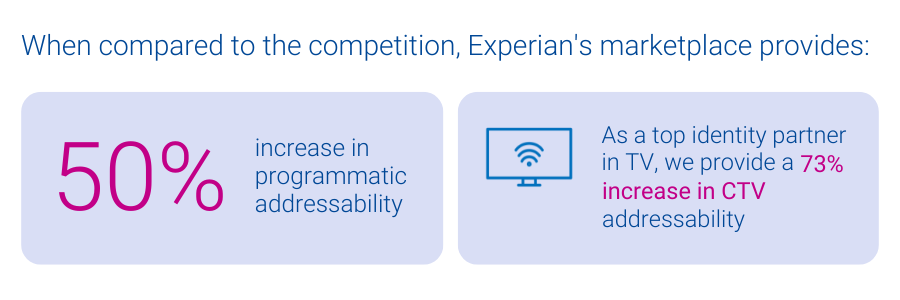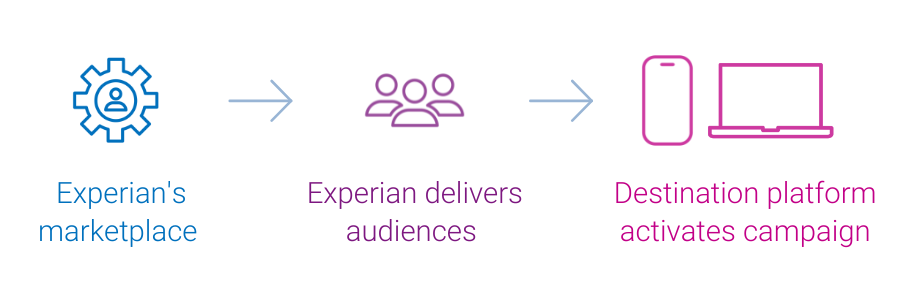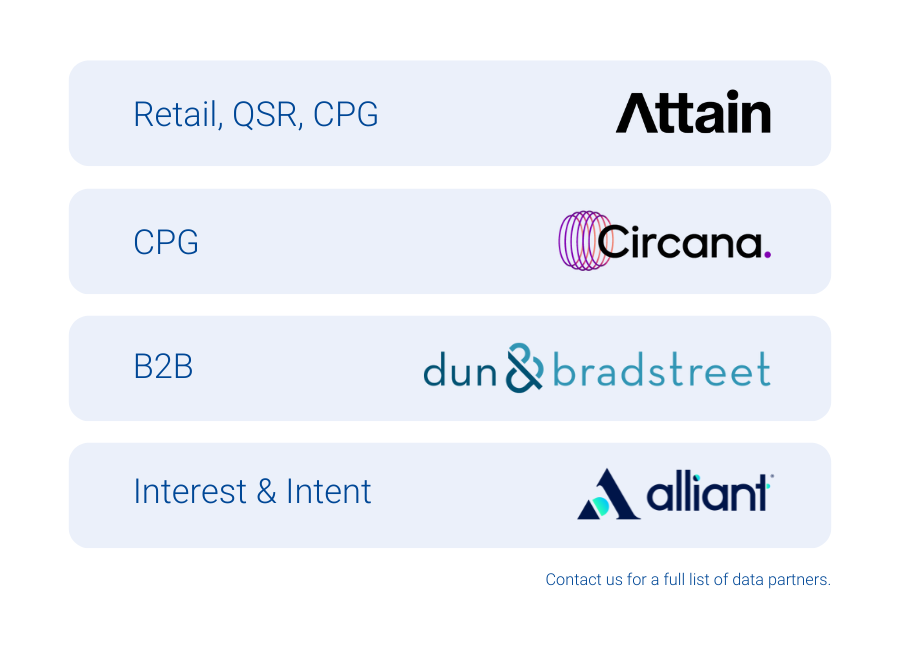
In a perfect world, we’d all have a single, go-to grocery store that carried everything on our shopping list – fresh produce, gourmet coffee beans, rare spices, and maybe even that special-grade olive oil, right alongside our wholesale bulk purchases at unbeatable prices. It would be convenient and efficient, and it’d save a lot of driving around town.
The changing data marketplace: From one-stop shop to specialized selection
For a long time, data buyers enjoyed something similar in their world: a small set of large-scale data marketplaces that offered a wide array of audiences, making it easy to load up on whatever you needed in one place. Not only are there fewer places to pick everything up, but new factors like privacy and signal deprecation are placing a spotlight on quality and addressability.
Just as our dinner plans are growing more ambitious insofar as we want health, flavor, value, and convenience all in one place – so are our data strategies. Instead of a single steak-and-potatoes meal, today’s data marketplace operators might be cooking up a complex menu of campaigns.
“Experian has been a longstanding partner of DISH Media, and we’re excited to be an early adopter of their marketplace which leverages the foundation of their identity solutions to ensure maximum cross-channel reach as we look to expand the breadth and depth of data we use for addressable TV.”
Kemal Bokhari, Head of Data, Measurement & Analytics, DISH Media
As a result, data buyers are beginning to shop around. Some still rely on large-scale marketplaces for familiar staples, but now they have reasons to explore other options. Some are turning to providers known for offering top-tier, transparently sourced segments. Others are focusing on specialty providers that excel in one area.
A more selective approach to data buying
In this environment, choosing where to “shop” for data is becoming more deliberate and selective. Data buyers aren’t just thinking about broad scale; they’re looking to prioritize quality, durability, data privacy, and differentiation. They need to place higher value on data marketplaces that can maintain audience addressability over time, despite signal loss. Sometimes, that means accepting a smaller assortment in exchange for tighter vetting and more reliable targeting. Other times it means mixing and matching – stopping by one marketplace for premium segments and another for cost-friendly, wide-reaching data sets. Either way, they can benefit from having more choices.
“Experian has been a longstanding partner of DISH Media, and we’re excited to be an early adopter of their marketplace which leverages the foundation of their identity solutions to ensure maximum cross-channel reach as we look to expand the breadth and depth of data we use for addressable TV.”
Kemal Bokhari, Head of Data, Measurement & Analytics, DISH Media
Experian’s marketplace: A trusted source for high-quality data
Experian’s vetted and curated blend of data partners and vertically-aligned audiences offers a trusted specialty store for data buyers. Experian’s marketplace, powered by identity graphs that include 126 million households, 250 million individuals, and 4 billion active digital IDs, enables partner audiences to be easily activated and maintain high addressability across display, mobile, and connected TV (CTV) channels. In particular, Experian’s marketplace provides:


The future of data marketplaces: Precision and flexibility matter
The evolution of data marketplaces reflects the industry’s shifting priorities. Data buyers seek specificity, reliability, and adaptability to align with their diverse campaign needs. The best data strategy, much like the best grocery run, isn’t about grabbing everything in one place – it’s about carefully selecting the right ingredients to create the perfect recipe for success. This shift underscores the importance of flexibility and precision as data buyers navigate a landscape shaped by privacy regulations, signal loss, and evolving consumer expectations.

As data marketplaces adapt to meet these demands, they are redefining what it means to deliver value. Experian’s marketplace enables buyers to strike the perfect balance between reach and quality by offering enhanced match rates, precise audience planning, and seamless distribution. In this new era, data buyers have the tools and options to craft campaigns that are impactful and aligned with the increasingly selective and privacy-conscious digital landscape. The key is recognizing that today’s data strategy is about utilizing the strengths of many to create a cohesive and effective whole.
If you’re interested in learning more about Experian’s marketplace or becoming an active buyer or seller in our marketplace, please contact us.
Latest posts

Email hashing was originally intended to be used as an email security feature that has ended up being a very powerful marketing tool. A hashed email is a cryptographic function that changes an email address to a random code which can be used as an anonymous customer identifier. This code is privacy-safe and cannot be traced back to the customer’s email address. However, this hashed email can function like a digital passport that traces every behavior and action a customer takes when logged into an account that is authenticated with an email, making hashed emails a goldmine for customer data. Today emails are used across traditional publishers and within the CTV ecosystem; tying them to more consumer touch points than ever before. Why the emphasis now? Cookies are on their way out the door and have been the primary way that many marketers have tracked their existing and potential customers. In order to replace this granular level of data, marketers are likely going to need multiple solutions. With so many cookieless solutions and IDs appearing in the marketplace, the mapping of the customer journey is bound to be fragmented. Relying on first-party data, such as hashed email, is just one way to reduce that fragmentation; as it can serve as an authenticated starting point for cross-device identity resolution that can be leveraged for targeting, personalization and measurement. How can Tapad + Experian help? Tapad + Experian's Hashed Email Onboarding is a privacy-safe way to connect consumer email addresses to their related digital devices and other digital identifiers through high precision probabilistic identity. By onboarding hashed emails and incorporating them within your Tapad Graph file you can: Build a more holistic view of individuals and households and their relationship to email addresses in your first-party data set Leverage these relationships for increased cross-device scale for targeting Employ personalization tactics at the household or individual level across devices Create new audience segments and look-alike models for cross-channel activation Design more inclusive measurement and attribution for customer journey mapping Tapad, a part of Experian has built a hashed email onboarding product feature that works with the existing flexibility of The Tapad Graph to deliver the most holistic consumer view, combined with the attributes you need, in the structure that works best for your business objectives. Get started with The Tapad Graph For personalized consultation on the value and benefits of The Tapad Graph for your business, email Sales@tapad.com today!

The result of epic shifts from traditional cable to streaming television, the CTV ecosystem is experiencing compounded fragmentation, making it challenging for marketers to leverage in the most effective way for both activation and measurement. Heralded as the hot new household level device for highly engaged viewers, CTV brings massive opportunities for brands to move users down the funnel and incorporate CTV into their attribution modeling post-campaign. Leveraging CTV IDs within a cross-device identity resolution strategy can yield big benefits if you know how to do it right. Check out our breakdown of today’s CTV landscape to help you better understand how and what you can leverage for activation and measurement in the streaming-verse today. CTV Ecosystems as identifiers (for illustrative purposes only) This is just a small peak at the players and complexities of CTV IDs available for marketers today, but it illustrates the need to understand what IDs can benefit your strategies and where you can use them. Addressability and attribution Not all CTV devices and IDs are addressable; or have ad slots for biddable inventory for advertisers. For example, Apple TV devices and Apple TV + are not ad supported, but could still appear within an identity graph for measurement purposes; helping understand customer behavior and habits, which can inform marketing strategies. Having a household to individual view that's as inclusive as possible can provide valuable insights. CTV identity strategy Whether or not CTV devices or apps are addressable for advertisers, they can bring immense value when leveraged as part of a holistic identity resolution strategy. As a household level device with user authentication it can provide marketers a top-down view; unlocking household:individual targeting opportunities and unification of IDs at both levels for frequency management and customer journey mapping Get started with us Tapad, part of Experian, offers CTV ID onboarding and extension to our CTV ID Universe as a part of The Tapad Graph suite of products. To learn more about how The Tapad Graph can support your business objectives through future-proof identity resolution visit Tapad.com or email sales@tapad.com to connect with a representative today.

Third-party data has become the cornerstone to improve marketing effectiveness across all types of online and offline media. Consumer packaged goods (CPG) marketing faces a challenge when utilizing this data, as sales are often made through distributors such as grocery stores or mass merchandisers rather than directly to consumers. Without customer data files that can be enriched for insight, CPG companies often base marketing decisions on custom market positioning studies, surveys and generic consumer personas. These solutions can be quite expensive and prove difficult to develop a targeted marketing program. Optimize your CPG marketing strategy We have a team of experts that leverage the wealth of our database of thousands of attributes covering more than 300 million U.S. consumers and 130 million U.S. households—to identify the demographics and attitudes of a CPG target consumer using syndicated, mobile location, social media, and online behavioral data. We help connect various data points to provide CPG marketers with the ability to identify likely consumers, generate actionable marketing insight, and enable targeted advertising to these consumers that increases brand awareness and drives purchase behavior. Identifying likely consumers for consumer packaged goods To gain marketing insight about your customers, you need to identify consumers who are actively engaged with your brand, and compare them against non-engaged consumers, or consumers engaged with rival brands. Experian uses syndicated and digital actions data to identify these consumers and understand their characteristics. With digital actions data, we leverage search terms and landing pages relevant to your brand. We use our linking capabilities to identify the perfect target audience for your marketing initiatives. For example, we leveraged syndicated data that showed consumer preference for frozen meals based on household characteristics. This enabled our client to better understand the market size and attributes of its active consumers. Actionable CPG marketing insight Once marketers identify who their optimal target consumer is, they can begin to understand their ideal audience and compare it to consumers of competitive brands. This helps identify key demographics and psychographics that over-index to users of the brands compared to the population. As a result, you can gain a much better understanding of the demographics, life stage and lifestyle of your target consumer. We also help you to better inform your marketing communication and media and distribution strategies by identifying the channels your ideal audience is most likely to be found. Getting back to our example, consumers of frozen foods were found more likely to be females between the ages of 35-54 with busy families. They had multiple children in the home and participated in family activities, like zoos and fast-food dining. We were then able to identify the digital channels they were more actively engaged with and determine factors that influence their decision-making, such as product quality or consumer testimonials. By gaining insight into your target audience, you can create digital communication focused on specifics, like an active family looking for a quality meal. Turning insights into action by enabling targeted advertising With a better understanding of your target consumer, and the insight needed to catch their attention, you can unify your ideal target audience and serve advertising that builds brand awareness and increases conversion. Our Custom Analytics team uses advanced analytical techniques to create custom consumer personas. Our database of 130 million U.S. households is scored with a proprietary algorithm created specifically for your organization and creates audiences that are pushed to the preferred marketing channel of your target consumers. Leveraging our ConsumerView database, we can easily enable direct communication to your targeted consumers (such as our example that identified consumers of frozen food and their preferred channels) through direct mail, email, digital display, social media and mobile channels. We work directly with agencies to deploy an audience to a destination and can manage a campaign for our CPG clients. We can even help you determine campaign success by measuring campaign performance versus a relevant control, and profiles converters to help you see gains made in brand awareness to target consumers. These services give you the ability to test an advertisement directly to targeted consumers, measure the effectiveness of the advertisement, then plow back the learnings into future campaigns, enabling greater consumer brand awareness and conversion while managing marketing effectiveness. Experian is here to help We have worked extensively with a variety of CPG companies to improve marketing effectiveness and drive brand awareness. We can help your organization take your marketing campaigns to the next level. Our data assets and advanced analytics generate actionable insights that enable you to identify and communicate with consumers more effectively. For more information about how we can help your organization gain valuable insights to identify your ideal customers and the best channels to reach them, contact us.